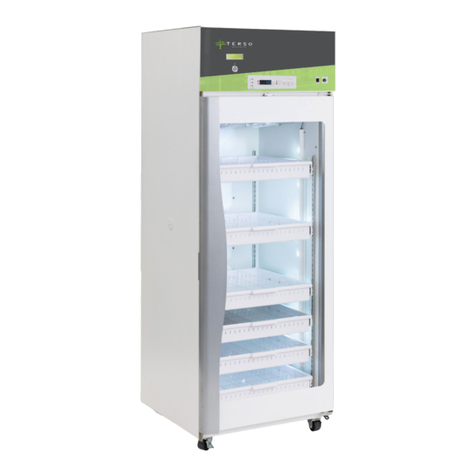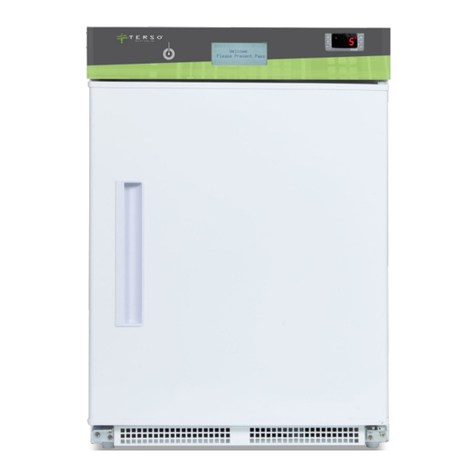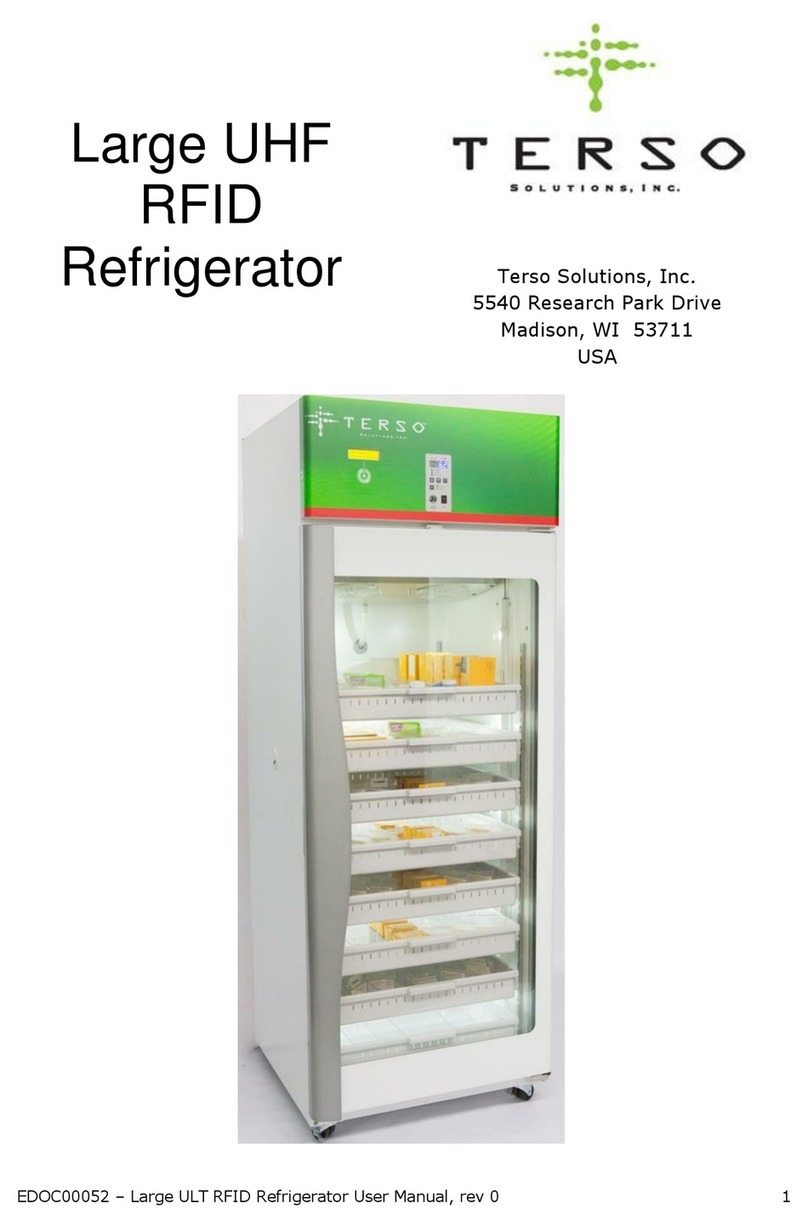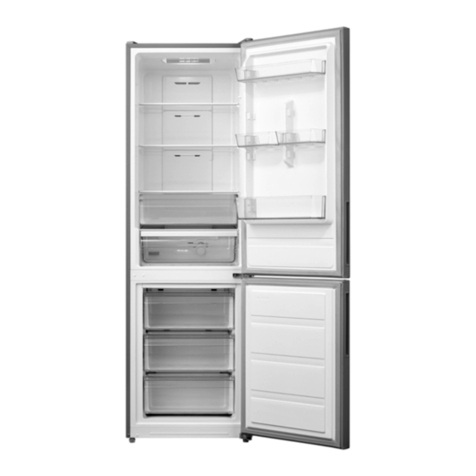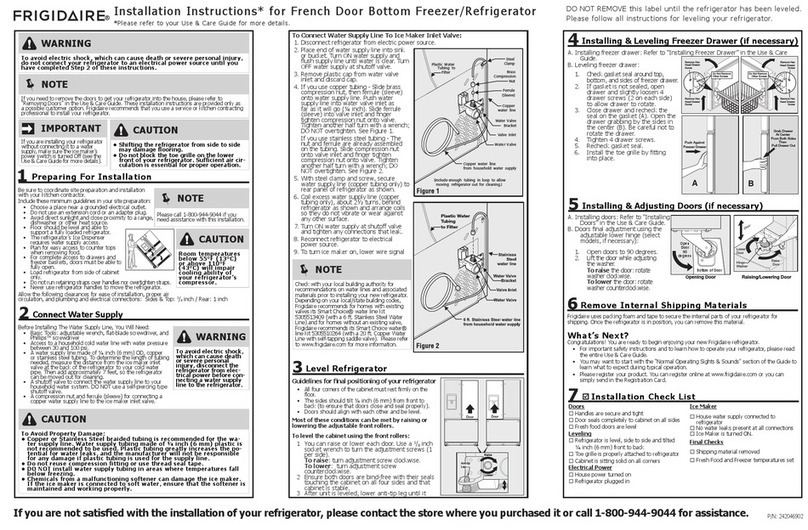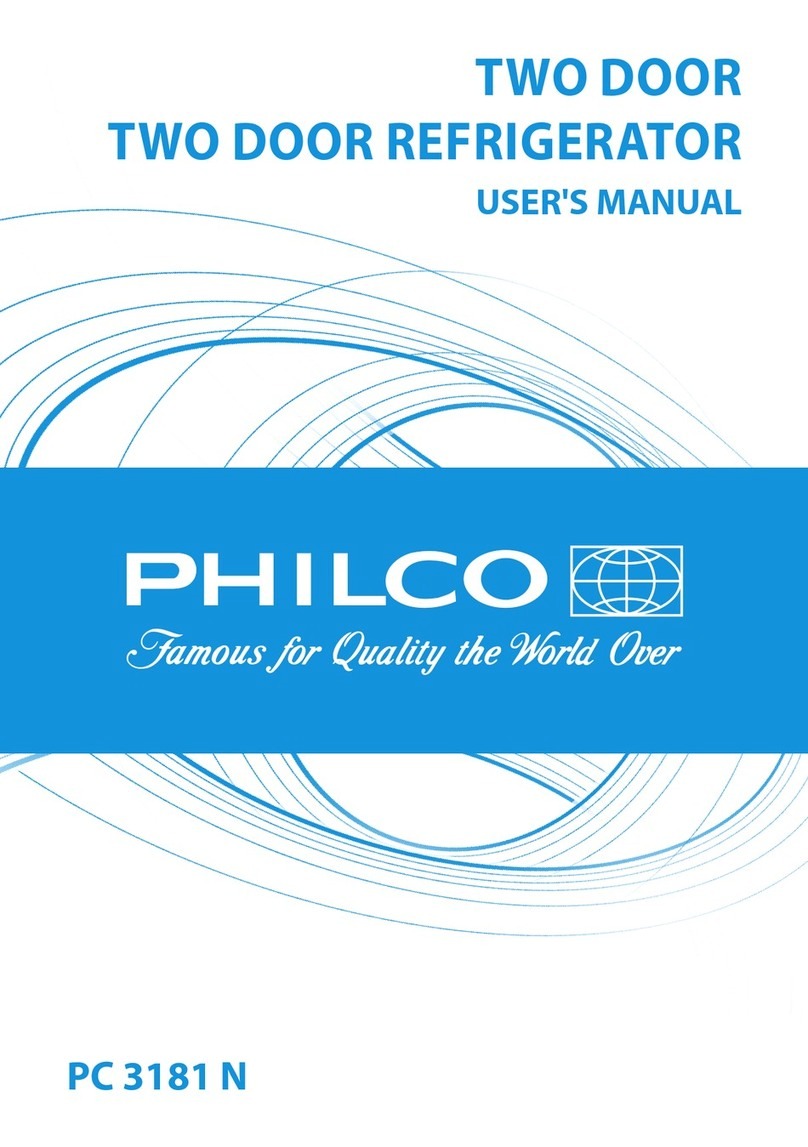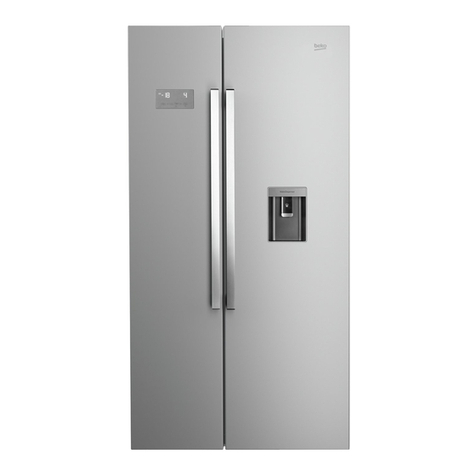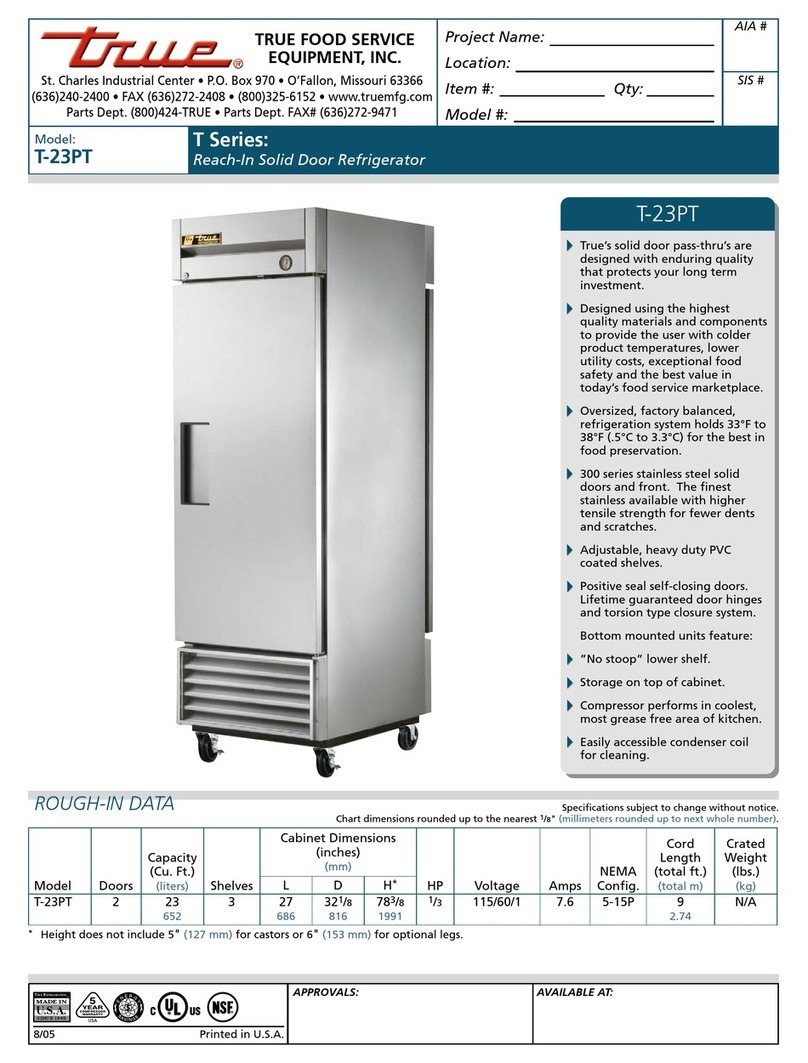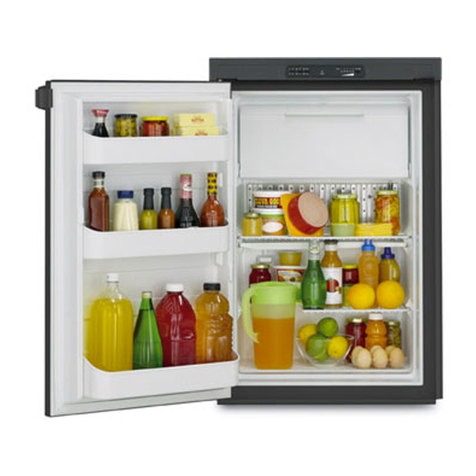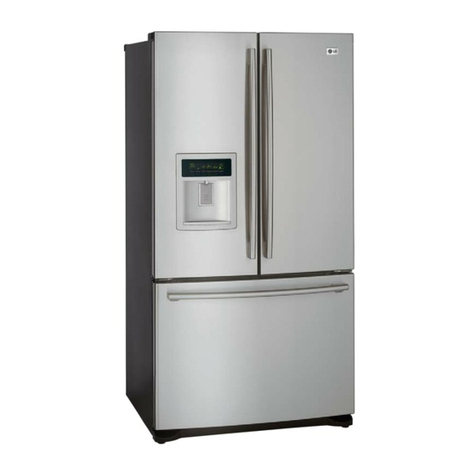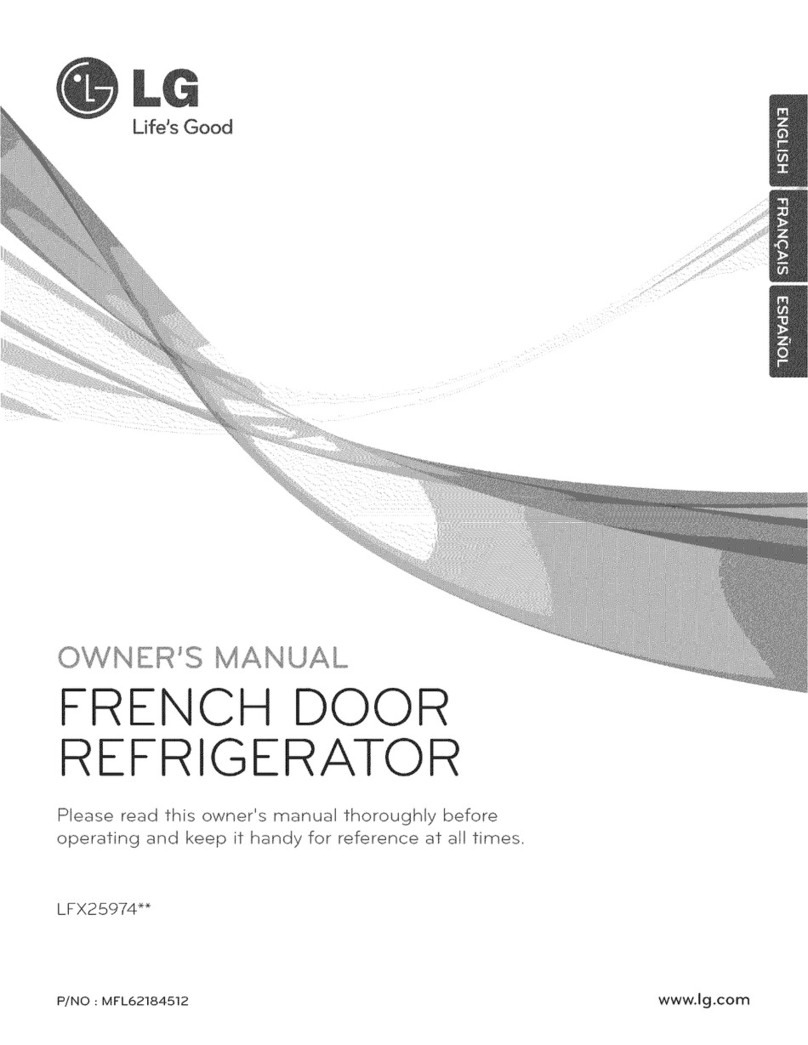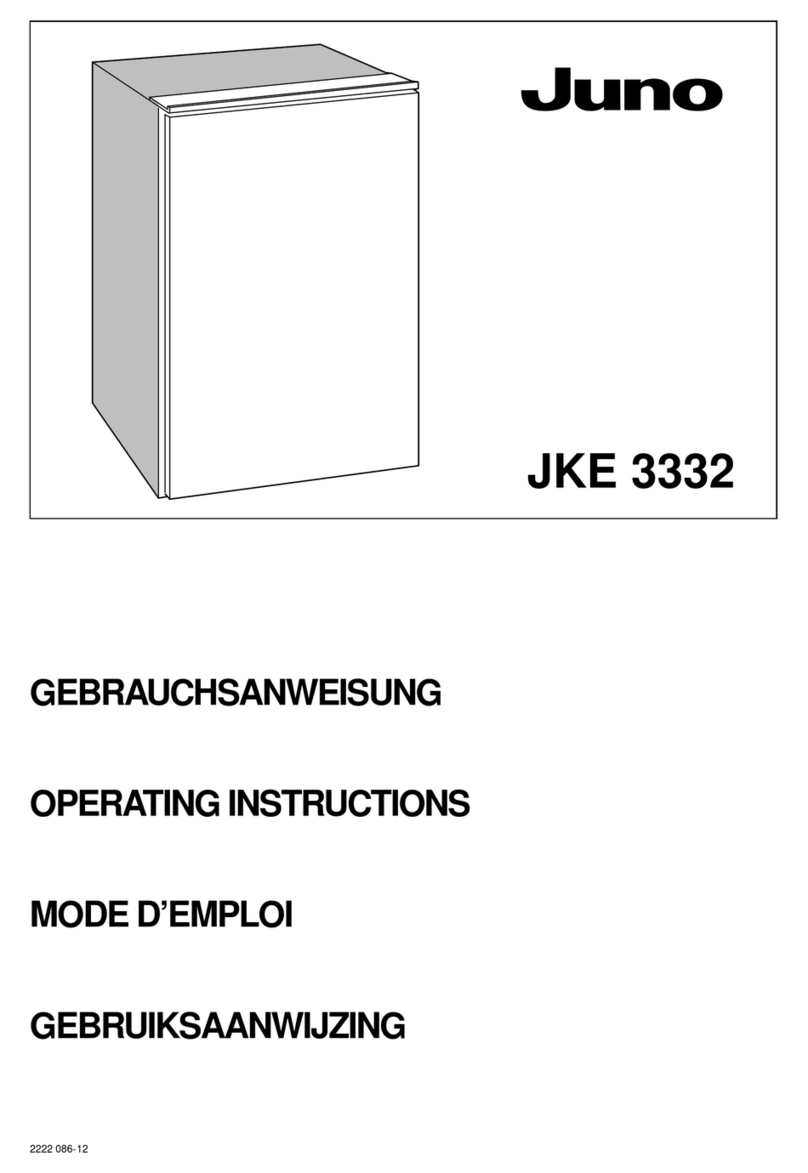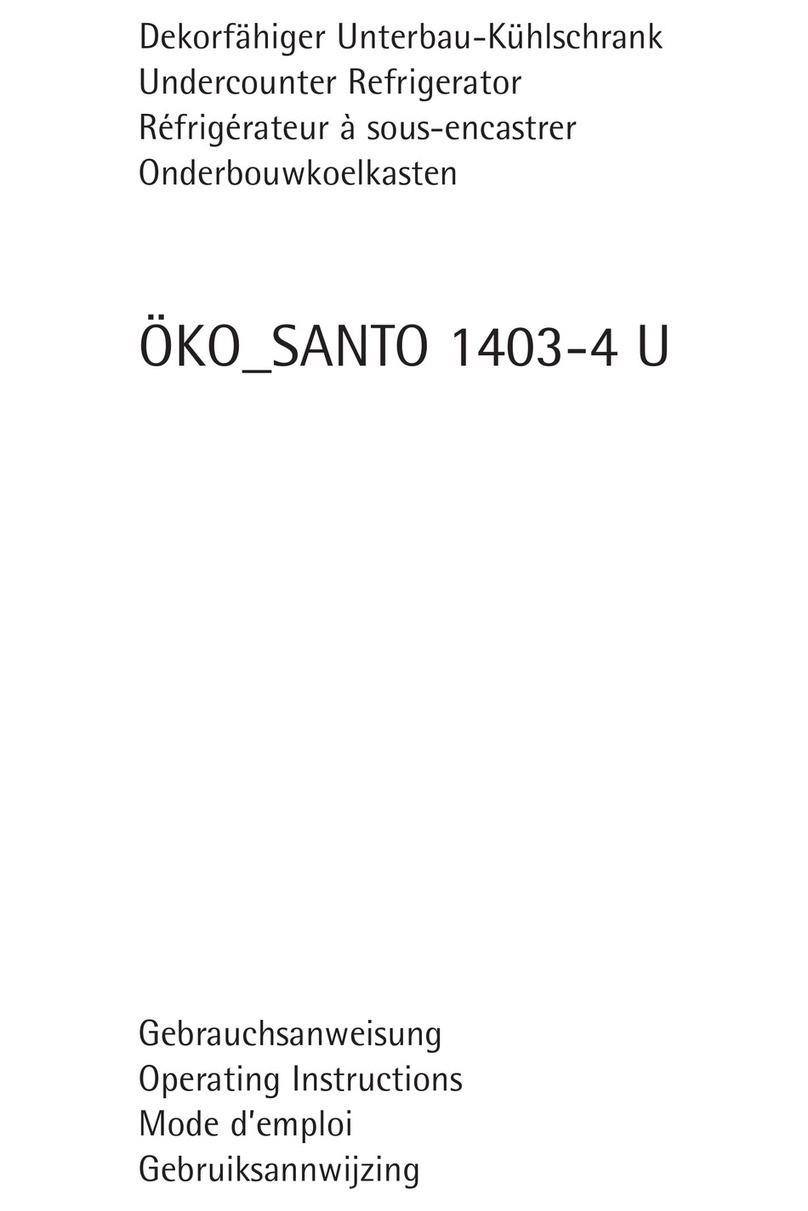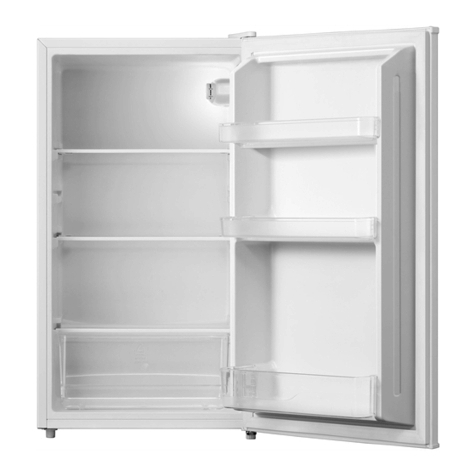TERSO TS098 User manual

Countertop RFID User Guide, REV3, 8/3/21 1
Countertop
RFID
Refrigerator
TS098

Countertop RFID User Guide, REV3, 8/3/21 2
TABLE OF CONTENTS
ABOUT THIS MANUAL............................................................................... 3
PRECAUTIONS FOR SAFE OPERATIONS ...................................................... 3
GETTING STARTED .................................................................................. 7
MAINTENANCE ...................................................................................... 10
TROUBLESHOOTING .............................................................................. 12
APPENDIX A: DEVICE SPECIFICATIONS ..................................................... 12
APPENDIX B: MODEL SPECIFICITIONS ............. Error! Bookmark not defined.
APPENDIX C: GLOSSARY ........................................................................ 13
APPENDIX D: SAFETY CHECKLIST ............................................................ 14

Countertop RFID User Guide, REV3, 8/3/21 3
ABOUT THIS MANUAL
Read this manual carefully before using the device and follow the instructions for safe operation.
Terso Solutions does not guarantee safe operation if the device is not used as intended as outlined
in this manual.
Keep this manual in a place easily accessible for all users. The contents of this manual are subject to
change without notice. Contact Terso Solutions Technical Support if a new manual is needed or if any point
in this manual is unclear.
PRECAUTIONS FOR SAFE OPERATIONS
It is imperative for users to comply with instructions outlined in this manual for safe operation.
Procedures are described so this device may be used correctly and safely. Following the precautions will
prevent possible injury to the user and damage to the device.
Precautions are illustrated in the following way:
Failure to observe WARNING signs could
result in a hazard to personnel possibly
resulting in serious injury or death.
Only use the system as specified in these
instructions.
Failure to observe CAUTION signs could
result in injury to personnel and damage to
the device and associated property.
•This symbol means an action is
prohibited.
•This symbol means an instruction
must be followed
Caution, read all accompanying documents
before operating the device.
This label is on the cover in which the
electrical components of high voltage are
enclosed to prevent electrical shock.
Be sure to store this manual in a location accessible to users.
This mark indicates the location of the protective earth conductor. Do not
disconnect. Disconnection of the protective earth conductor may impair the
protection provided by the device.

Countertop RFID User Guide, REV3, 8/3/21 4
Risk of shock is present inside the device. The cover should be removed by qualified
engineers or service personnel only.
Do not use the device outdoors. Exposure to water may lead to current leakage or electric
shock.
Install the device in stable location. If the installation site is not adequate, injury or damage
to device may result from the device tipping over.
Do not install the device in a flammable or volatile location. This may cause explosion or
fire.
Do not install device in presence of acid or corrosive gases. This may lead to corrosion
resulting in current leakage or electrical shock.
Dedicate a power source to be used exclusively for device.
Remove dust from the power supply plug before inserting in a power source. A dusty
plug or improper insertion may pose a hazard.
Use a power supply outlet with ground (earth) to prevent electric shock. If the power supply
outlet isnot grounded, it will be necessary to have qualified engineers install a ground.
Always unplug device using the power supply plug, not the cord. Pulling the cord may
result in electric shock or fire by short circuit.
Do not damage or break the power supply plug or cord. Do not use the supply plug if its
cord isloose. This may cause fire or electric shock.
Do not touch any electrical parts such as power supply plug or any switches with a wet
hand. This may cause electric shock.
Do not ground the device through a gas pipe, water main, telephone line or lightening
rod. Such grounding may cause electric shock in the case of an incomplete circuit.
Do not insert metal objects such as a pin or wire into any outlet, vent, or gap for inner air
circulation.This may cause electric shock.
If this device will be used for storing poisons, radioactive material, or other harmful
products, ensure that it is in a safe area. Failure to do so may lead to an adverse effect on
the health of personnel in the area and local environment.

Countertop RFID User Guide, REV3, 8/3/21 5
Do not splash water directly onto the device as this may cause electric shock or short
circuit.
Do not disassemble, repair, or modify this device yourself. Any such work carried out by
anunauthorized person may result in fire or injury due to a malfunction.
Disconnect the power supply plug if there is something wrong with the device.
Continued abnormaloperation may cause electric shock or fire.
If the device is to be stored unused in an unsupervised area for an extended period, ensure
that children do not have access and that doors cannot be closed completely.
Prepare a safety check sheet when you request any repair or maintenance for the safety of
servicepersonnel.
Do not disconnect the protective earth conductor. Disconnection may impair the
protection providedby the equipment.
Do not place any switches or disconnect device from the earth conductor.
Do not climb onto the device. This may cause injury by tipping or damage to the device.
This device is equipped with an automatic door closing mechanism, always hold the
handle whenclosing the door. This will reduce the likelihood of a trapped finger.
Do not lean on the door. This may cause injury if the device tips over.
Always disconnect the power supply plug before moving the device. Take care not to
damage thepower cord. A damaged cord may cause electric shock or fire.
Be careful not to tip over the device during movement to prevent damage or injury.
Always disconnect the power plug when the device is not used for long periods of time.
Always disconnect the power supply to the device prior to any repair or maintenance of
the device to prevent electric shock or injury.

Countertop RFID User Guide, REV3, 8/3/21 6
Cautions for Using the Device
•Never store corrosive materials such as acid or alkali unless the container is completely sealed.
Corrosion may lead to failure of the device in time.
•Always close the door firmly. The door open alarm will sound after the door is open for five minutes
unless configured otherwise. The alarm will be canceled automatically when the door is closed.
•Always open and close the door gently. Rough operation may lead to stored items location shifting,
incomplete closing, or damage of the door and auto closing mechanism.
•Items should be added to the device in small batches to minimize temperature increase.
Environmental Conditions
This device is designed to be safe under the following conditions:
•Indoor use only
•Up to 2000 m / 6550 ft altitude
•+18 °C to +30 °C, ≤ 80% relative humidity
•Over Voltage Category II
•Pollution degree 2 (normal office conditions)
•Main supply voltage fluctuations up to ± 10% of the nominal voltage

Countertop RFID User Guide, REV3, 8/3/21 7
GETTING STARTED
Components
Figure 1: View of Back Panel Location
Figure 2: View of Front Panel Location
Device Front Figure 3
A. USB interface jack
B. Pass reader
C. LCD display
D. Refrigerator controller
Device Back Panel Figure 4
A. AC circuit breaker
B. Hardware reset
C. Ethernet jack
D. RFID system power switch
E. Emergency door release
F. Alarm mute switch
Figure 3: Front Panel

Countertop RFID User Guide, REV3, 8/3/21 8
Figure 4: Back Panel
Unpacking the Device
Inspection
Before unpackaging the device, inspect for any damage that may have occurred during transit. If any
damage is present, please contact Terso Solutions Technical Support at +1 888.376.0257.
Unpacking
•Remove the straps and remove all packaging. Gently position the device in place on the ground.
•Remove accessories from inside the device. Items included are a power cable and Ethernet
cable. Other items may also be included such as cables and bins, or other device specific items.
Proper Handling
Do not use push the handle to move the device. Always move the device with the door facing you. Carefully
roll the device into designated location leaving at least a 4 inch (in.) gap between the back of the device and
the wall.
Installation
Site
When choosing an install site, reference state and federal requirements prior to installation in a medical
setting and designate backup device to store contents if the device has an unforeseen issue.
For proper operation and maximum performance, install the device in a location which meets the following
conditions:
Correct power outlets
Device requires a grounded 120 V 10 A NEMA 5-15 outlet.
Do not connect device to a GFI (Ground Fault Interrupt) circuit.
Do not use an extension cord or any multi-outlet strip or plug. Using such equipment can
cause insufficient power leading to component failure.
Sturdy and level floor
Install the device on a sturdy floor to ensure proper door alignment.
Do not install on unstable floor. This may result in user injury from device tipping.
Dry location with minimal humidity
Do not operate device outdoors. Exposure to humidity or water may result in current
leakage or electric shock.
Never install the device in humid location or a place where it is likely to be splashed by
water. This may result in current leakage or electric shock.
Do not install the device under water pipes or steam pipes. This may result in current
leakage or electric shock.
Absence of flammable or corrosive gas

Countertop RFID User Guide, REV3, 8/3/21 9
Never install device in a flammable or volatile location.
This may cause explosion or fire.
Never install the device where acid or corrosive gases are present as current leakage or
electric shock may result due to corrosion.
Leveling the device
Properly level the device before use. Appropriate leveling is critical to the device’s successful operation. To
level the device, set a level on the top of the device. If the device is not level, adjust the front leveling legs.
Connecting to AC Power
Plug the device into a grounded wall outlet with a minimum of a 15 A rating. See specifications for further
details. The power outlet must be within 10 feet (ft) / 3 meters (m) of the device and be easily accessible. In
an emergency the power cord can be unplugged and turn off the device.
Connecting Communications
Plug the Ethernet cable into device back panel followed by appropriate wall data jack or cellular router.
Initial Device Loading
Allow device to operate at desired temperature for a minimum of 4 hours before loading with inventory. If
stocking ambient temperature products, load the device one shelf at a time, beginning with the top shelf.
After loading each shelf, allow the device to recover to the desired set point before loading the next shelf.
Repeat this process until the device is fully stocked.
Access Verification
Present a valid access pass to device pass reader located to the left of the LCD display on the front panel.
Once accepted, the LCD display text will indicate the door is now unlocked. Device door can be closed at
any time and will relock automatically. Check door is locked by gently pulling on the door handle.
Remote Alarm Contacts
Alarm contacts on the back of the device are available to wire the device into an alarm system. These
contacts alarm on high/low temperature, power outages, and control probe failures.
Third-Party Temperature Systems
The device is equipped with a probe access port for any third-party temperature monitoring system.
To access the port, remove the white caps from back of device and run the probe through to the interior. The
port location is indicated with a label. Reseal the port hole with putty to prevent outside air from getting into
the device. Mount the probe inside the device near labeled location. Refer to third-party probe installation
guide for further details. Do not run a temperature probe across device door gasket, this may cause
excessive condensation or frosted evaporator.
Operating Instructions
Device is equipped with a digital temperature controller designed to provide full temperature control of the
device. The controller provides a constant readout of inventory temperature inside device. Keypad buttons
allow the user to easily select the display devices, set point, and alarm information.
The controller has been factory set and tested to allow your device to operate at its desired temperature
cycle. Please consult the manufacturer’s documentation for additional instructions on using the temperature
controller.
Adjusting the settings on the controller will override the factory settings. It is recommended to consult with
Terso’s technical support department prior to adjusting controller.
Basic Access Process

Countertop RFID User Guide, REV3, 8/3/21 10
An end user will present an access pass to the pass reader on the device. The access pass needs to be
presented close to the pass reader to be read. The LCD display will indicate granted access when a valid
access pass has been presented.
The user now can open the door for a configurable time period, normally about five seconds. Otherwise, the
user will need to present an access pass again. Once unlocked, desired inventory may be added or
removed. The device will give an audible alarm if the door is left open for more than one minute or
configured alarm time.
Once products have been added or retrieved close the device door. The door will automatically lock, and the
inventory process will begin and take about a minute to complete. The resulting updated inventory will then
be sent to Terso Solutions for processing. The device will not be accessible during the inventory process.
Access will then be restored, and the process can be repeated.
Device Alarms
All device alarms are automatically sent to Terso Solutions. Terso Solutions’ staff may contact on site staff to
assist in correcting a potential problem.
Alarm Types
Door Ajar
When the device’s door is left open for longer than one minute, an audible alarm will sound, and the LCD
display will show “Please close door” until the door is closed. If the door appears to be closed, verify nothing
is obstructing the door and attempt to re-close.
Power Outage
In the event of a power outage, an audible alarm will sound, the LCD display will change to “AC power fail”.
The alarm will continue until AC power has been restored or the onboard UPS system runs out of power.
Device cooling will not function during a power failure. Once power has been restored, the device will
perform an inventory scan and resume normal operation.
Temperature
The device continuously monitors internal temperature with specific temperature probes installed by Terso
Solutions. If a temperature alarm is triggered, Terso Solutions’ staff will contact on site staff to help
troubleshoot and/or move temperature sensitive products to a safe location. The device may prevent access
if inventory integrity has been compromised or until temperature stabilizes.
Hardware Failure
The device will automatically attempt to correct any system errors preventing correct function. However, in
the event of a hardware component failure, the device may lock down to prevent access. Terso Solutions’
staff will be in contact with on-site staff if this is the case.
Door Breach
If the device door is forced open a notification will indicate there has been unauthorized access or a door
breach. This information is communicated to Terso Solutions as part of a specific event where no access
pass was used to access the inventory inside the device. Any products taken will be reported as a standard
event but without access pass identification information.
MAINTENANCE
There are no user serviceable parts in the device. Please contact Terso Solutions for any service-related
inquiries. Terso recommends that the user perform periodic maintenance items as listed below:

Countertop RFID User Guide, REV3, 8/3/21 11
Always disconnect the power supply to the device prior to any repair or maintenance to prevent shock
or injury.
Cleaning
Exterior Cleaning
Use a dry cloth to wipe off the outside and inside of device and all accessories. If device outside panels are
dirty, clean them with a diluted neutral dishwashing detergent (undiluted detergent can damage the plastic
components. For the dilution refer to the instruction of the detergent.) After cleaning with diluted detergent,
always wipe off the same areas with a wet cloth. Wipe off excess moisture on device or accessories with a
dry cloth. Never pour water onto or into the device. Doing so can cause electric shock or a short circuit.
Do not clean the device with scrubbing brushes, acid, thinner, solvents, powdered soap, cleanser, or hot
water. These agents can scratch the paint or cause it to peel. Plastic and rubber parts can be easily
damaged by these materials. Especially never use any volatile solvent to clean the plastic or rubber parts.
When a neutral dish washing detergent is used to clean the device, wipe it up thoroughly with a cloth soaked
in clean water and sanitize with a 70% IPA solution.
Interior Cleaning
If the interior of the device requires cleaning, refer to in house safety procedures to ensure any harmful
materials are handled and cleaned correctly.
Cleaning the Door Gasket
The door gasket should be cleaned monthly. Using a soft cloth, remove any frost build-up from the gasket
and door(s). The door gasket may need to be cleaned more frequently if dirt or excessive frost build-up
prevents the door from closing properly.
Cleaning the Condenser
The condenser should be cleaned once per year at a minimum. Clean the condenser using a vacuum
cleaner exercising care to not damage the condenser fins. Depending upon environmental conditions, the
condenser may need to be cleaned more frequently.
Cleaning Agents and Tips
ITEM CLEANING AGENT TIPS AND PRECAUTIONS
Interior and door liners Soap and water
Baking soda and water
Use 2 tablespoons of baking soda in 1 quart of warm
water.
Be sure to wring excess water out of sponge or cloth
before cleaning around controls, light bulb, or any
electrical parts.
Door gaskets Soap and water
Wipe gaskets and their seating surfaces with a clean,
soft cloth.
Shelves and drawers Soap and water Do not wash removable shelves in dishwasher.
Exterior and handles Soap and water
Non-abrasive glass cleaner
Do not use commercial household cleaners,
ammonia, or alcohol to clean handles.
Use a soft cloth to clean smooth handles.
Do not use a dry cloth to clean smooth handles.

Countertop RFID User Guide, REV3, 8/3/21 12
TROUBLESHOOTING
If the device appears to not be operating correctly, check to ensure that it is plugged into a wall outlet and
powered on. If further support is needed, contact Terso Technical Support at +1 888.376.0257. Support can
also be contacted by visiting http://support.tersosolutions.com.
APPENDIX A: DEVICE SPECIFICATIONS
FEATURES
SPECIFICATION
ELECTRICAL REQUIREMENTS
Electrical power & frequency
115 VAC, 60 Hz, 2 A
Power consumption
0.9 kW/day (average)
RFID battery backup
12 VDC SLA, qty 2
Plug style
NEMA 5-15
COMMUNICATIONS
Connection
Ethernet LAN standard, cellular and WiFi optional
ENVIRONMENTAL
Operating temperature
18 oC to 30 oC
Operating humidity
5% to 95% non-condensing
REFRIGERATION
Operating temperature
+1 °C to +10 °C
Refrigerant
R600a (SNAP)
Cooling method
Forced air circulation
Defrost type
Automatic
PHYSICAL ATTRIBUTES
External dimensions (H x W x D)
23.0 in. x 18.0 in. x 18.0 in.
Internal dimension (H x W x D)
15.75 in. x 14.0 in. x 8 in.
External clearance (H x W x D)
25.0 in. x 26.0 in. x 35.0 in.
Volume
1.0 ft3
Unit weight
60 lbs.
Maximum shelf capacity
10 lbs.
RFID
Frequency
902 to 928 MHz
Standard
RAIN RFID: EPCglobal UHF RFID Class 1 Gen2v2 / ISO 18000-63
REGULATORY
FCC
Class B digital device, pursuant to Part 15 of the FCC Rules
RoHS
RoHS 2011/65/EU compliant
* Specifications may change without notice.

Countertop RFID User Guide, REV3, 8/3/21 13
APPENDIX C: GLOSSARY
TERM
DESCRIPTION
CONDENSER A condenser is the part within a refrigerated device that's responsible for
cooling the temperature down.
FCC
Federal Communications Commission www.fcc.gov.
MHZ
Megahertz is used to measure the transmission speed of radiofrequency
products. Megahertz is equal to One million cycles per second.
IPA
An acronym for Isopropyl Alcohol
LCD
An acronym for Liquid Crystal Display
NEMA
An acronym for the US National Electrical Manufacturers Association that sets
standards for power plugs and receptacles.
RAIN RFID
RAIN RFID is a global alliance promoting the universal adoption of UHF RFID
technology.
RFID
An acronym for Radio Frequency IDentification.
RFID BATTERY BACKUP
Provides power to Terso electronics to remain operational when the device has
lost electrical power. Indicated by V, Ah, SLA.
RFID TAG (OR TAG)
A radio frequency tag, or label that communicates with the RFID Reader. RFID
tags consist of three major components – An RFID microchip, an RFID
antenna, and a physical label with or without adhesive.
ROHS
RoHS stands for Restriction of Hazardous Substances. RoHS originated in the
European Union and restricted
the use of specific hazardous materials found in
electrical and electronic products.
SCAN OR SCANNING
Capturing data from products labeled with an RFID tag.
SNAP
An acronym for the US FDA’s Significant New Alternatives Policy for
environmentally friendly refrigerants.
USB
Universal Serial Bus (USB) is an industry standard that establishes
specifications for cables and connectors.

Countertop RFID User Guide, REV3, 8/3/21 14
APPENDIX D: SAFETY CHECKLIST
Please fill out this form before servicing and ensure that the unit is properly marked with any applicable
markings to denote any hazards inside.
Provide this form to the service engineer to keep for safety purposes.
SAFETY CHECKLIST
Device Contents:
Risk of infection
Yes
No
Risk of toxicity
Yes
No
Risk of radioactive sources
Yes
No
Please list any potentially hazardous materials that have been stored in this device:
Contamination of the device:
No contamination
Yes
No
Decontaminated
Yes
No
Contaminated
Yes
No

Countertop RFID User Guide, REV3, 8/3/21 15
APPENDIX E:
TERSO SOLUTIONS, INC. TS098, COUNTERTOP RFID REFRIGERATOR WARRANTY – USA
AND CANADA
TERSO SOLUTIONS, INC. TS098 COUNTERTOP RFID REFRIGERATOR WARRANTY – USA AND CANADA
Read the TS098 Countertop RFID Refrigerator User Manual before operating the device, accessories, or software (defined collectively
and individually as the “Terso Device”) and keep it for future reference. This document contains important Terms and Conditions.
Electronic acceptance, opening the device packaging, use of the device, or retention of the device constitutes acceptance of these
Terms and conditions.
Terso Solutions, Inc. warrants the Terso Device against defects in materials and workmanship when used normally in accordance with
Terso’s guidelines for a period of 36 months from date of shipment to the customer (“Warranty Period”).
This Standard Limited Warranty is conditioned upon proper use of the Device.
This Standard Limited Warranty does not apply: (a) to consumable parts, such as plastic drawers and dividers, or protective coatings
that may diminish over time, unless failure has occurred due to a defect in materials or workmanship; (b) to cosmetic damage, including
but not limited to scratches, dents and broken plastic unless failure has occurred due to a defect in materials or workmanship; (c) to
damage caused by use with a third-party component or product that does not meet Terso Device’s specifications; (d) to damage caused
by accident, abuse, misuse, fire, liquid contact, earthquake or other external cause; (e) to damage caused by operating the Terso
Device outside Terso’s published guidelines; (f) to damage caused by service (including upgrades and expansions) performed by
anyone who is not a representative of Terso; (g) to a Terso Device that has been modified to alter functionality or capability without the
written permission of Terso; (h) to defects caused by normal wear and tear or otherwise due to the normal aging of the Terso Device, (i)
if any serial number has been removed or defaced from the Terso Device; or (j) if Terso receives information from relevant public
authorities that the device has been stolen or if you are unable to deactivate the device or other security measures designed to prevent
unauthorized access to the Terso Device, and you cannot prove in any way that you are the authorized user of the device (e.g. by
presenting proof of purchase), (k) defects or damage resulting from excessive force or use of a metallic object to open secured panels,
or any breakage of the device glass door, (l) equipment that has the serial number or the enhancement data code removed, defaced,
damaged, altered or made illegible, (m) ordinary wear and tear.
Important: Do not remove the Terso electronics panel or attempt access the electronics. Opening the Terso Device may cause damage
that is not covered by this Warranty. Only Terso or an authorized service representative should perform service on this Terso Device.
If during the Warranty Period you submit a claim to Terso or in accordance with this warranty, Terso will, at its option:
(i) repair the Terso Device using new or previously used parts that are equivalent to new in performance and reliability, or
(ii) replace the Terso Device with the same model (or with your consent a device that has similar functionality) formed from new and/or
previously used parts that have been reconditioned, rebuilt, or new parts but are equivalent to new in performance and reliability.
All warranty returns must be made using Terso’s RMA process. Terso is not responsible for shipping costs to return the device for a
warranty claim. Terso is not responsible for any damage caused by poor packaging of the device being returned and has the right to
refuse replacements, repairs, or exchanges if device is damaged due to packaging or during shipment.
Following warranty service your Terso Device or a replacement device will be returned to you at Terso’s cost as your Terso Device was
configured when originally purchased, subject to applicable updates. Repaired or replaced devices are covered for the remainder of the
original warranty. Replacement or repair of component parts or equipment under this warranty shall not extend the warranty to either the
equipment or to the component part(s) beyond the original 36-month warranty period.
THIS WARRANTY IS EXCLUSIVE AND IN LIEU OF ALL OTHER WARRANTIES, WHETHER WRITTEN, ORAL, OR IMPLIED. NO
WARRANTIES OF MERCHANTABILITY OR FITNESS FOR A PARTICULAR PURPOSE SHALL APPLY.
EXCEPT AS PROVIDED IN THIS WARRANTY AND TO THE MAXIMUM EXTENT PERMITTED BY LAW, TERSO IS NOT
RESPONSIBLE FOR DIRECT, SPECIAL, INCIDENTAL OR CONSEQUENTIAL DAMAGES RESULTING FROM ANY BREACH OF
WARRANTY OR CONDITION, OR UNDER ANY OTHER LEGAL THEORY, INCLUDING BUT NOT LIMITED TO LOSS OF USE; LOSS
OF REVENUE; LOSS OF ACTUAL OR ANTICIPATED PROFITS (INCLUDING LOSS OF PROFITS ON CONTRACTS); LOSS OF THE
USE OF MONEY; LOSS OF ANTICIPATED SAVINGS; LOSS OF BUSINESS; LOSS OF OPPORTUNITY; LOSS OF GOODWILL;
LOSS OF REPUTATION; LOSS OF, DAMAGE TO, COMPROMISE OR CORRUPTION OF DATA; OR ANY INDIRECT OR
CONSEQUENTIAL LOSS OR DAMAGE HOWSOEVER CAUSED INCLUDING THE REPLACEMENT OF EQUIPMENT AND
PROPERTY, ANY COSTS OF RECOVERING, PROGRAMMING OR REPRODUCING ANY PROGRAM OR DATA STORED IN OR
USED WITH THE TERSO DEVICE OR ANY FAILURE TO MAINTAIN THE CONFIDENTIALITY OF INFORMATION STORED ON THE
TERSO DEVICE.
THE FOREGOING LIMITATION SHALL NOT APPLY TO DEATH OR PERSONAL INJURY CLAIMS, OR ANY STATUTORY LIABILITY
FOR INTENTIONAL AND NEGLIGENT ACTS AND/OR OMISSIONS. TERSO DISCLAIMS ANY REPRESENTATION THAT IT WILL
BE ABLE TO REPAIR ANY TERSO DEVICE UNDER THIS WARRANTY OR REPLACE THE TERSO DEVICE WITHOUT RISK TO OR
LOSS OF INFORMATION STORED IN THE TERSO DEVICE.
If equipment service is required, please call Terso’s Technical Services Department at +1 888.376.0257 (USA and Canada).
Table of contents
Other TERSO Refrigerator manuals
